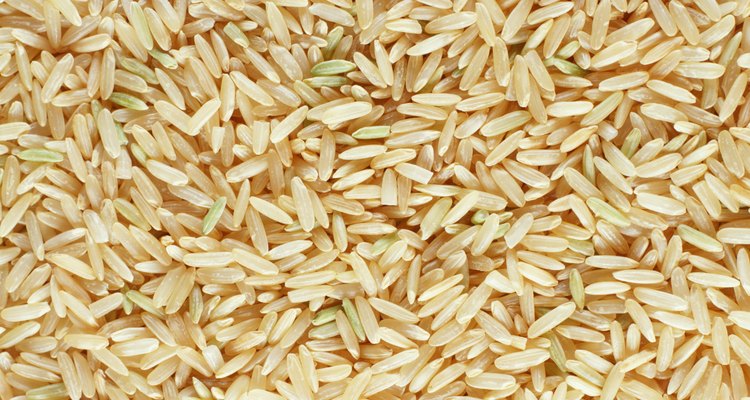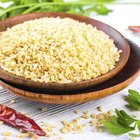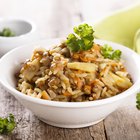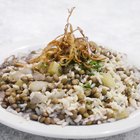
Chad Baker/Jason Reed/Ryan McVay/Photodisc/Getty Images
Whole-grain rice retains all of the grain’s natural nutrients. One of its biggest benefits comes from the amount of dietary fiber it contains, which you won’t get from processed rice. You can also count on getting complex carbohydrates for energy and at least 10 percent of your recommended dietary allowance of eight vitamins and minerals.
Types of Whole-Grain Rice
Brown rice and wild rice are both natural whole grains. A whole grain must contain all three parts of the grain, the endosperm, bran and germ. To produce white rice, the bran and germ are removed, so it's not a whole-grain product. Since a significant amount of fiber, vitamins and minerals are contained in the bran and germ, white rice loses nutrients. One cup of cooked brown rice has 216 calories, 5 grams of protein and 45 grams of carbohydrate. The same portion of wild rice contains 166 calories, 6.5 grams of protein and 35 grams of carbs.
Natural Fiber
Getting the recommended amount of fiber in your diet protects your health because it lowers cholesterol and prevents constipation. Chances are you need to increase your fiber intake. Most Americans only consume about half of their recommended daily fiber intake, according to the “Dietary Guidelines for Americans 2010.” Since most of the grain’s fiber is in the bran, white rice only retains a small amount. One cup of cooked brown rice provides 3.5 grams of fiber, while wild rice has 3 grams. By comparison, you’ll only get 0.6 grams of fiber from 1 cup of cooked white rice. Women should consume 25 grams of fiber daily, while men need 38 grams.
Rich Source of Magnesium
About 50 to 80 percent of the grain’s minerals are lost when the bran is removed, reports Kansas State University. Even enriched rice only has 19 milligrams of magnesium in 1 cup. The same portion of brown rice contains four times more. It supplies 84 milligrams, or 21 percent of the daily value. Wild rice has slightly less, but it’s still a good source, with 52 milligrams. Magnesium is essential for producing energy and DNA. It may also help lower blood pressure and reduce levels of triglycerides in your bloodstream, reports a review of research published in August 2012, in the “Annals of Nutrition and Metabolism.”
Vitamin B-6 for Metabolism
Vitamin B-6 fills a variety of roles in your body, from keeping nerves working to metabolizing protein and synthesizing antibodies used by your immune system to fight diseases. It also helps make hemoglobin, which is found in red blood cells and has the job of carrying oxygen throughout your body. As a result, lack of vitamin B-6 in your diet may cause anemia, according to PubMed Health. One cup of cooked brown rice provides 0.28 milligrams of vitamin B-6, or 14 percent of the daily value. Wild rice has almost the same amount with 0.22 milligrams, while enriched white rice only has 0.15 milligrams of vitamin B-6.
Related Articles

Is Jasmine Rice Naturally White or Is ...

Bulgur Vs. Farro
How to Cook Volcano Rice

How Long After a Sell-By Date Can You ...

Whole vs. Low-Fat Buttermilk

The Nutrition of Stone Ground Corn
Difference Between Short-Grain & ...

Nutrition and Protein in Rice

The Calories in Garbanzo Beans

How to Cook Long Grain Rice

How to Cook Golden Rose Rice
Substitutes for Oat Bran

Does Brown Rice Ever Get Soft?

How to Cook Brown Basmati Rice

Rice and Lentils for Nutrition

Nutrition From Beans & Rice

What Is a Semibrown Rice Zojirushi?

Is Soy Milk Casein-Free?

Do Lentils & Rice Have Calcium & ...

Difference Between Red Rice & Brown Rice
References
- NutritionValue.org: Rice, Cooked, Long-Grain, Brown
- USDA Nutrient Database: Wild Rice, Cooked
- USDA Nutrient Database: Rice, White, Long-Grain, Regular, Cooked, Enriched
- Kansas State University: Healthful Whole Grains
- U.S. Department of Agriculture: Dietary Guidelines for Americans 2010
- University of California Davis: Some Facts About Fiber
- Linus Pauling Institute: Magnesium
- Annals of Nutrition and Metabolism: Magnesium: Novel Applications in Cardiovascular Disease -- A Review of Literature
Writer Bio
Sandi Busch received a Bachelor of Arts in psychology, then pursued training in nursing and nutrition. She taught families to plan and prepare special diets, worked as a therapeutic support specialist, and now writes about her favorite topics – nutrition, food, families and parenting – for hospitals and trade magazines.
Photo Credits
Chad Baker/Jason Reed/Ryan McVay/Photodisc/Getty Images